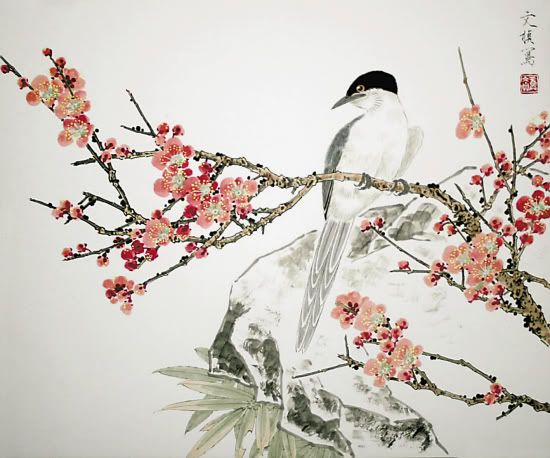The alternate and more appropriate title should be "How a decent piece of jade is ruined by shitty carve work" but I guess I should reserve the profanity for the post body, consider there are kids reading this blog and that tomorrow is the Chinese/Lunar New Year...(time to save some karma for myself).
This white jade plaque was one of my first purchases as I was dabbling into the world of vintage jade. The piece depicts two magpies surrounding what could possibly be two plum blossoms (called Xi Shang Mei Shao). It's a common topic for Chinese art which literally translates into "Magpies on Plum Branch" and figuratively means "Overflown with Joy" (It's a homonym again). Anyway, the carve work is so abstract that I could barely tell the two birds apart from the giant mess...
An example of Xi Shang Mei Shao (done right) - by Chinese contemporary artist Gong Wenzhen, who is currently teaching at the Central Academy of Fine Arts. I also have some vintage Chinese carnelian pieces under the same topic but I am keeping those for later.

Back to topic - The piece of jade is rather typical of late Qing (1800s to early 1900s) since it's done in the typical La Si/Pulled Wire method (and seriously, no contemporary artist will ruin it like this) - To do the filigree design on a jade back in the old days, the artisan would first pierce a thin jade flab with diamond (a small quantity has been discovered in China since 1600s) then put a wire through the hole. At one end, the wire is secured at the working station, at the other end, it's pulled and maneuvered by hand and the tension is what they used to cut the jade.
Cutting hard pieces like this with a tense string would inevitably leave some ridges but with time and craftsmanship, the ridges are usually not noticeable...With the exception of this (which looks like it's done by some apprentice with shaky hands). Anyway, if the piece was actually well-done, it might end up as a Qing businessman's belt charm, passed to his children then consequently destroyed by the communist during Cultural Revolution...Instead, it has made its way to the US (it's pretty ironic that most Chinese antique are better kept outside of China), to my hands and now I am complaining about the carve work. Isn't that kind of funny?


That is funny.
ReplyDeleteThat's so interesting about how they used to carve jade. I wonder if a contemporary craftsman could fix the carving a bit?
Yeah, I guess the plaque is thick enough to be sanded off on both side and re-done altogether, which is not uncommon even in contemporary jade carving but I guess many would chose to keep the old one since it's damage-free itself (so there is little need to fix something that's not broken).
Deletecompletely ignorant about jades here, but i think it looks like 2 chickens ^.^
ReplyDeleteI inherited 3 pieces of carved Jade from the 1600s...do you know a lot about them...your article sounded like you have done a lot of research on them?
ReplyDeleteNot sure if my comment was posted.... I was wondering if you could give me some insight on 3 pieces of carved jade I inherited??
ReplyDeleteThis comment has been removed by a blog administrator.
ReplyDelete